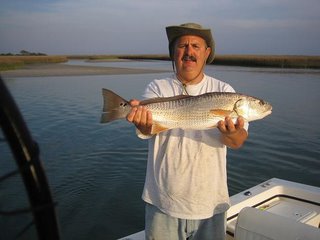Topsail Angler Weekly Column - April 24, 2006
Here's a copy of my weekly printed column, The Topsail Angler.
The Red Drum is our official state saltwater fish. This fish is often called puppy drum while in its juvenile form. Red drum is also called redfish, and blackened redfish, which was a cooking sensation in the late 1980s and early ’90s, was made with this species
The red drum lives to be very old for a fish, well past 30 years, and grows very large. The state record catch is 94-pounds, 2-ounces set in 1984 at Hatteras Island. Red drum mature to adulthood in about four years and live in the open ocean. The adults frequent the surf in search of a meal and can be a lot of fun to catch on surf gear.
The juvenile, or puppy, drum lives on the sound side of our barrier islands. While much smaller than the adult version -- weighing less than 10 pounds -- they are also fun to catch on light tackle.
The red drum fishery was over-fished and many were considered "by-product" in commercial fishing nets. The North Carolina Marine Fisheries agency stepped in and set up regulations to restore the population to sustainable levels. These efforts have paid off. As a result, the redfish in our state have made a strong recovery. Currently, anglers are allowed to keep one fish per day, and it must be between 18 and 27 inches in length. Mature females are 28 inches or larger, so the upper limit preserves the brood stock.
Redfish are a favorite target of state anglers year-round, with fall and spring being the best seasons. Targeting and catching drum in the marsh and creeks can be very challenging and rewarding. They eat a range of crustaceans and small fish, with small crabs being among their favorite meal. You will often find them on the oyster bars and marsh banks in very shallow water.
They are usually in schools and are spooky when in shallow water, so approach them carefully. Drifting into them or using a pole to push your boat are both sound methods. You often can spot their tails on the surface of the water. When in the shallow water, they are usually feeding on the bottom. They can get into an almost vertical position when working the mud bottom, so their tails will break the surface allowing you to locate them. Anglers and guides refer to this as a "tailing redfish".
When they are tailing, they are feeding, so just about any bait will work. I like to use grubs on a quarter-ounce jighead or small crabs when available. Whatever you choose, the key is to cast the bait three feet or so in front of the fish. Make as soft of a cast as possible to minimize the sound of the bait entering the water. Then just hang on, if you didn’t spook the school and have your bait in position, a bite is almost assured when they are tailing.
Now for this week’s catching report: Inshore, the red drum and trout bite remains strong with an occasional flounder being caught. In the surf, look for red drum and bluefish to be active. The bonito action has really heated up at the near-shore reefs and wrecks.
Surf City Pier reports the bluefish have arrived. Tyler Davis had the catch of the week, with the youngster catching a 12-pound bluefish on the pier. They also report the mullet bite is still strong.
Jolly Roger Pier reports the bluefish have shown up in numbers this week with flounder, drum and trout in the mix. The first Spanish mackerel of the season was caught this past weekend with water temperatures reaching 68 degrees.
Offshore and Gulf Stream fishing has been very good lately, with kings in the 30 mile and out range. Many boats have reported catching limits of yellowfin tuna in the stream. Wahoo, black fin and dolphin are also being caught.
Tight lines to all!

